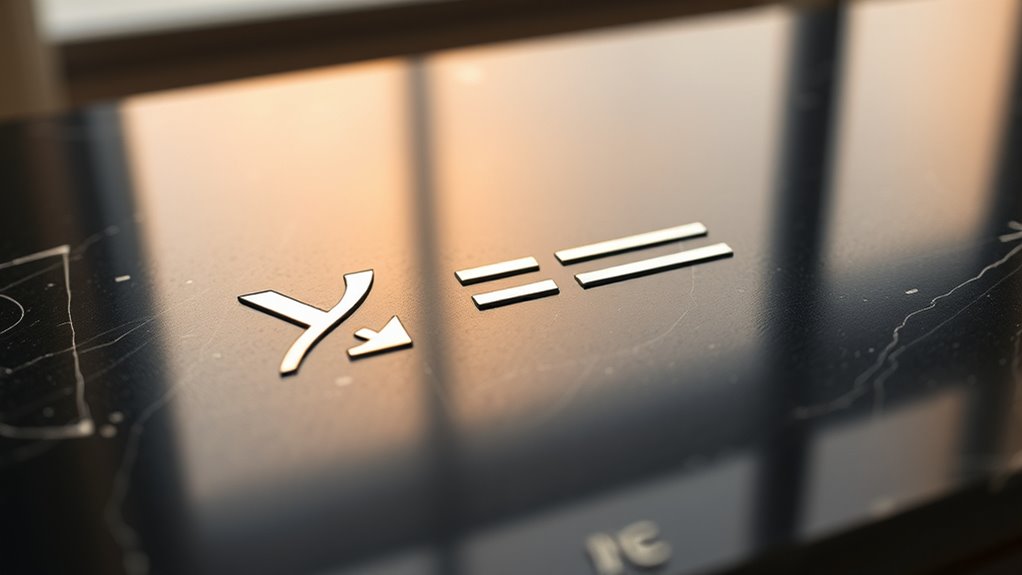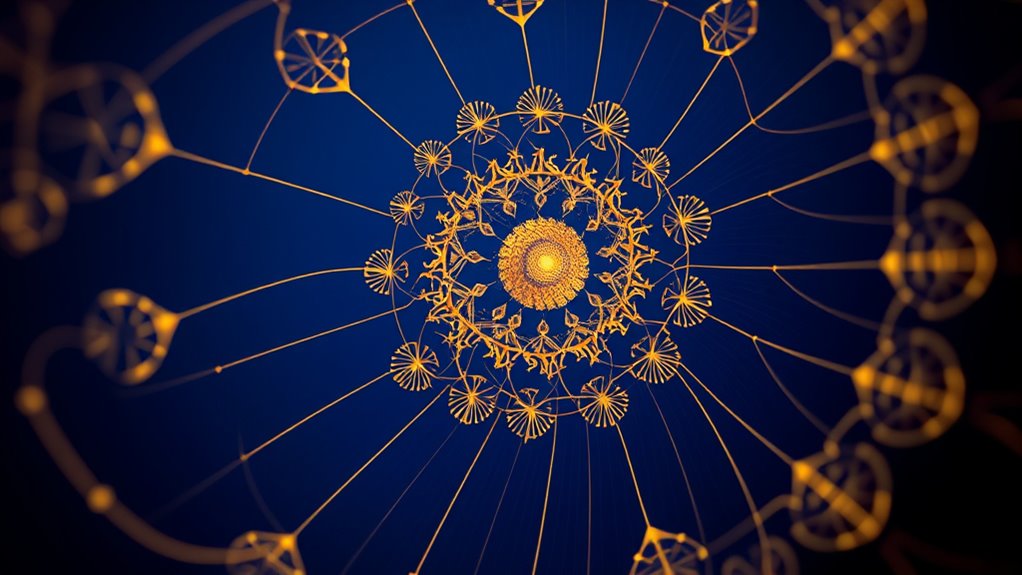Certain equations evoke emotion because they reveal a deep sense of harmony, order, and elegance that taps into your innate appreciation for beauty. When you recognize patterns or formulas like E=mc² or Fibonacci spirals, it’s not just about numbers or shapes — it’s about perceiving universal truths and the underlying structure of reality. These moments of recognition spark awe and wonder, showing the profound connection between math and the beauty of the universe. Keep exploring to understand why this happens.
Key Takeaways
- Elegant equations often embody simplicity and universality, triggering appreciation through perceived harmony and truth.
- Recognizable patterns in equations resemble natural forms, creating a sense of order that evokes emotional resonance.
- The visual and conceptual balance in mathematical formulas enhances their aesthetic appeal and emotional impact.
- Pattern recognition in mathematics connects us to universal principles, inspiring awe and a sense of enlightenment.
- Mathematical beauty transforms abstract symbols into emotionally powerful symbols of harmony and the universe’s inherent order.

Have you ever marveled at the elegance of a perfect equation or the symmetry in a geometric pattern? It’s a moment where your mind recognizes something inherently beautiful—something that resonates beyond mere numbers or shapes. This sense of aesthetic appeal isn’t accidental; it’s rooted in the way our brains process and appreciate patterns. When you see a mathematical equation that feels complete or a pattern that repeats flawlessly, your brain instinctively engages in pattern recognition. This isn’t just about identifying shapes or sequences; it’s about perceiving harmony, order, and balance. These qualities evoke an emotional response because they tap into a deep-seated preference for structure and coherence. Your mind is wired to seek out patterns because they provide clarity amidst chaos, and when you encounter a particularly elegant one, it triggers a sense of wonder. Recognizing these visual and mathematical patterns reveals the profound connection between nature and human perception.
Recognizing perfect patterns sparks wonder, revealing harmony and beauty beyond numbers and shapes.
Mathematical beauty often lies in its simplicity and universality. Equations like Einstein’s famous (E=mc^2) or the Fibonacci sequence seem to encapsulate profound truths in a compact form, which amplifies their aesthetic appeal. The sheer elegance of such formulas isn’t just in their meaning but in their form—the way symbols come together to create a sense of completeness. You might find yourself captivated by the way these equations balance complexity and simplicity, creating a visual and intellectual harmony that feels almost artistic. This harmony is what makes certain equations evoke emotion—they represent more than just mathematical relationships; they symbolize truth, elegance, and a glimpse into the universe’s underlying order.
Pattern recognition plays a vital role in appreciating mathematical beauty because it allows your brain to connect disparate elements into a cohesive whole. When you recognize a pattern—like the spirals in a sunflower or the symmetry in a snowflake—you experience a sense of familiarity and satisfaction. These patterns are often embedded in nature, and when mathematical formulas mirror them, your appreciation deepens. Your brain responds positively because it perceives these patterns as evidence of underlying rules governing the world. This recognition fosters a feeling of insight or enlightenment, making the experience of understanding a beautiful equation or pattern profoundly rewarding.
In essence, the aesthetic appeal of mathematics lies in its ability to reveal order, harmony, and hidden connections. When you see an elegant equation or a perfect geometric pattern, it’s not just an intellectual exercise but a visceral experience. Your brain’s pattern recognition mechanisms allow you to feel awe and admiration, transforming cold numbers into something emotionally resonant. That’s why certain equations evoke emotion—they embody the beauty of the universe itself, waiting to be discovered and appreciated through your senses and mind.
Frequently Asked Questions
How Do Mathematicians Define Beauty in Equations?
When you ask how mathematicians define beauty in equations, they often see it as a blend of aesthetic perception and intellectual elegance. You might notice that beautiful equations are simple yet profound, revealing deep connections effortlessly. Mathematicians value clarity, symmetry, and the ability of an equation to unify concepts. Ultimately, beauty in math resonates through its harmony, elegance, and the sense that it captures something fundamental about the universe.
Can Mathematical Beauty Be Subjective or Universally Recognized?
You wonder if mathematical beauty is subjective or universally recognized, and the answer isn’t simple. While some see elegance in symmetry and simplicity, subjective appreciation plays a role, shaped by personal experiences and cultural influences. Yet, many mathematicians feel a universal allure in certain equations, hinting at a shared, underlying harmony. The mystery remains—what resonates deeply in one might differ for another, but some truths seem to transcend individual perspectives.
What Role Does Symmetry Play in Mathematical Aesthetic Appeal?
Symmetry plays a pivotal role in your perception of mathematical aesthetic appeal because it creates visual harmony that naturally attracts your eye. When you recognize patterns of symmetry, your brain finds it easier to process and appreciate the structure. This pattern recognition sparks a sense of elegance and balance, making equations more compelling. Symmetry taps into your innate desire for order, enhancing your emotional response to mathematical concepts.
Are There Specific Equations Considered the Most Beautiful?
You might find that some equations are considered the most beautiful because of their visual elegance and conceptual simplicity. Equations like Einstein’s E=mc² or Euler’s identity showcase this beauty, blending clarity with depth. These formulas capture complex ideas simply, inspiring awe. Their symmetry and elegant structure evoke emotion, making them stand out as symbols of mathematical perfection that resonate deeply with both mathematicians and enthusiasts alike.
How Does Mathematical Beauty Influence Scientific Discovery?
When you recognize mathematical beauty, you’re seeing how quantum elegance and fractal harmony can spark discovery. This allure guides scientists to focus on elegant, simple theories, making complex problems more approachable. By appreciating these aesthetic qualities, you can see how they act as a compass, inspiring breakthroughs and deepening understanding. Fundamentally, beauty in math fuels curiosity and innovation, turning abstract equations into powerful tools for scientific progress.
Conclusion
Ultimately, mathematical beauty is like a secret garden that invites you in with its harmony and elegance. When an equation resonates with you, it’s as if you’ve discovered a hidden melody in the universe’s symphony. These equations aren’t just numbers; they’re the art in science that stirs your soul. Embrace the wonder, and let the elegance of math remind you that beauty can be found in the most unexpected places.









